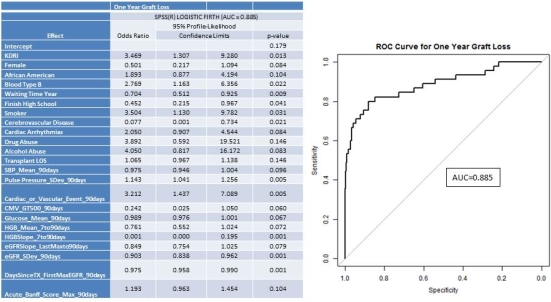One-Year Graft Loss Risk in Kidney Transplants – A Big Data Approach.
MUSC, Charleston, SC
IBM Corp., Armonk.
Meeting: 2016 American Transplant Congress
Abstract number: B47
Keywords: Graft survival, Outcome, Prediction models, Resource utilization
Session Information
Session Name: Poster Session B: Disparities in Access and Outcomes
Session Type: Poster Session
Date: Sunday, June 12, 2016
Session Time: 6:00pm-7:00pm
 Presentation Time: 6:00pm-7:00pm
Presentation Time: 6:00pm-7:00pm
Location: Halls C&D
Background Predictive models using national data are limited by lack of evolving patient level data. A Big Data approach using both static and dynamic variables may improve accuracy of stratifying patients by graft loss (GL) risk.
Methods: In a quality improvement project, we developed a predictive risk model using baseline and follow up data (structured and unstructured; up to 90-days post-tx). We included adult solitary kidney transplant recipients transplanted from 2007-15. We excluded: 1) GL in first 7 days post-tx, or 2) did not have a GL recorded nor any other data during the first year post-transplant. Structured data were directly extracted from electronic medical records (EHR, UNOS, Txp database (Velos)) and Natural Language Processing (IBM Watson) was applied to unstructured text to extract Banff scores and select vitals. IBM SPSS Modeler/ Essentials for R were used for analysis. Backward Selection Process was used at the 20% level for variable selection, and statistical significance was determined at the 5% level.
Results:Of 1,175 patients 3.8% experienced 1-yr GL. In addition to SRTR variables, we analyzed dynamic evolution of biologically relevant variables such as blood pressure, hemoglobin and eGFR during the first 90-days post-transplant; 40% of patients were female, 53% African American, the average age being 52 years. Variables significantly associated with increased 1-yr GL included KDRI, blood type B, smoker at time of transplant, pulse pressure standard deviation, and cardiac /vascular events

. Variables significantly associated with lower one-year GL included waiting time, finishing high school, cerebrovascular disease, hemoglobin slope from day 7-90 , eGFR standard deviation from day 0-90 and days from transplant to first maximum eGFR. The predictive model AUC was 0.88 (95% CI: 0.82-0.95), suggesting strong model accuracy

.
Conclusion: A Big Data solution to analyzing EHR data accurately predicts 1 year graft loss risk and captures dynamic evolution of biologic and socioeconomic mediators of risk. This approach is automatable and EHR deployable on a daily basis in the clinic to accurately identify patients at high risk of early graft loss.
CITATION INFORMATION: Srinivas T, Taber D, Zhang J, Su Z, Marsden J, Tripathi A, Moran W, Mauldin P. One-Year Graft Loss Risk in Kidney Transplants – A Big Data Approach. Am J Transplant. 2016;16 (suppl 3).
To cite this abstract in AMA style:
Srinivas T, Taber D, Zhang J, Su Z, Marsden J, Tripathi A, Moran W, Mauldin P. One-Year Graft Loss Risk in Kidney Transplants – A Big Data Approach. [abstract]. Am J Transplant. 2016; 16 (suppl 3). https://atcmeetingabstracts.com/abstract/one-year-graft-loss-risk-in-kidney-transplants-a-big-data-approach/. Accessed November 3, 2025.« Back to 2016 American Transplant Congress
